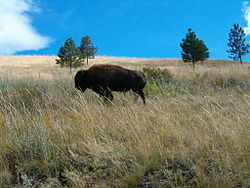- National Bison Range
-
National Bison Range IUCN Category IV (Habitat/Species Management Area)Location Lake / Sanders counties, Montana, USA Nearest city Missoula, MT Coordinates 47°19′20″N 114°12′42″W / 47.32222°N 114.21167°WCoordinates: 47°19′20″N 114°12′42″W / 47.32222°N 114.21167°W Area 18,500 acres (74 km²) Established 1908 Visitors est. 250,000 (in 2004) Governing body U.S. Fish and Wildlife Service The National Bison Range (NBR) is a National Wildlife Refuge located in western Montana established in 1908 to provide a sanctuary for the American bison. The NBR is one of the oldest National Wildlife Refuges in the United States. The size of the bison herd at the NBR is relatively small, numbering between 350 to 500 individuals. The initial herd of American bison was provided by organizations including the American Bison Society, and today the refuge serves as the central point for bison research in the United States.
The NBR consists of approximately 18,500 acres (28.91 sq mi; 74.87 km2) and is managed by the U.S. Fish and Wildlife Service. Other nearby National Wildlife Refuges are managed as parts of the National Bison Range Complex and include the Lost Trail, Ninepipe, Pablo and the Swan River National Wildlife Refuges. Also affiliated is the Northwest Montana Wetland Management District.
Once believed to number in the tens of millions, bison once were found in all the current U.S. states except Hawaii and also throughout Canada. By 1890, bison were almost extinct, having been part of a Federal government sponsored program of eradication during the Indian Wars, thereby removing a vital food source from the Plains Indians diet, and ensuring easier relocation onto Indian reservations. The bison was also considered to be a less desirable food source over domesticated cattle because of their wild nature, and were viewed as competition for prime grazing lands that could be used by cattle. By the beginning of the 20th century, efforts were made to attempt to preserve the remaining bison and protect areas in which they could reconstitute. Today, approximately 250,000 bison can be found on federal and state lands, as well as in privately owned herds. Bison has an average of 40% less fat content per pound over beef and a higher protein content as well. Most of the private herds are used as a food source. Bison is gaining in popularity, and can often be found in grocery stores and restaurants.
The refuge provides a visitor center and two scenic roads that allow vehicular access to prime viewing areas. Elk (wapiti), mule deer, bighorn sheep and black bear also live on the refuge along with over 200 bird species. The refuge is approximately one hour north of Missoula, Montana with signs off of U.S. Highway 93 directing visitors to the entrance at Moiese, Montana, and the refuge headquarters.
External links
Federal National Parks:National Monuments:National Battlefield:Lewis and Clark National Historic Trail • Nez Perce National Historic Trail • Continental Divide National Scenic Trail Pacific Northwest National Scenic TrailNational Recreation Area:Benton Lake • Black Coulee • Bowdoin • Charles M. Russell • Creedman Coulee • Hailstone • Halfbreed Lake • Hewitt Lake • Lake Mason • Lake Thibadeau • Lamesteer • Lee Metcalf • Lost Trail • Medicine Lake • National Bison Range • Ninepipe • Pablo • Red Rock Lakes • Swan River • UL Bend • War HorseNational Wild & Scenic Rivers:State Ackley Lake • Anaconda Smoke Stack • Bannack • Beaverhead Rock • Beavertail Hill • Big Arm • Black Sandy • Brush Lake • Camp Baker • Chief Plenty Coups • Clark's Lookout • Cooney • Council Grove • Eden Bridge • Elkhorn • Finley • First Peoples Buffalo Jump • Fort Owen • Frenchtown Pond • Giant Springs • Granite Ghost Town • Greycliff Prairie Dog Town • Hell Creek • Lake Elmo • Lake Mary Ronan • Lewis and Clark • Logan • Lone Pine • Lost Creek • Madison Buffalo Jump • Makoshika • Medicine Rocks • Missouri Headwaters • Painted Rocks • Parker Homestead • Pictograph Cave • Pirogue Island • Placid Lake • Rosebud Battlefield • Salmon Lake • Sluice Boxes • Smith River • Spring Meadow Lake • Thompson Falls • Tongue River Reservoir • Tower Rock • Travelers' Rest • Wayfarers • West Shore • Whitefish Lake • Wild Horse Island • Yellow BayState Forests:Coal Creek • Stillwater • Swan River
Wildlife Management Areas:Amelia Island • Aunt Molly • Badlands • Beartooth • Beckman • Big Lake • Blackfoot-Clearwater • Blackleaf • Blue Eyed Nellie • Bowdoin • Buffalo Head Park • Bull River • Calf Creek • Canyon Creek • Canyon Ferry • Dodson Creek • Dodson Dam • Dome Mountain • Ear Mountain • Elk Island • F Island • Flathead Lake • Flathead River • Fleecer Mountain • Fox Lake • Freezout Lake • Fresno Reservoir • Fresno Tailwater • Gallatin • Garrity Mountain • Grant Marsh • Gravelly-Blacktail • Haymaker • Hinsdale • Horseshoe Lake • Howard Valley • Isaac Homestead • Judith River • Kootenai/Falls • Kootenai/West • Kootenai/Woods Ranch • Lake Helena • Lost Creek • Lower Stillwater Lake • Madison-Bear Creek • Madison-Wall Creek • Milk River • Mount Haggin • Mount Jumbo • Mount Silcox • Nevada Lake • Ninepipe • North Swan Valley CE • Pablo • Ray Kuhns • Robb-Ledford • Rookery • Roundhom • Sanders • Seven Sisters • Silver Gate • Silver Run • Smith River • Sun River • Swan Lake • Thompson-Fisher CE • Three Mile • Threemile • Vandalia • War Dance Island • Warm SpringsHeritage registers:
World Heritage Sites • Biosphere Reserves • National Register of Historic Places • National Historic Landmarks • National Natural LandmarksCategories:- IUCN Category IV
- National Wildlife Refuges in Montana
- Protected areas of Lake County, Montana
- Protected areas of Sanders County, Montana
Wikimedia Foundation. 2010.



